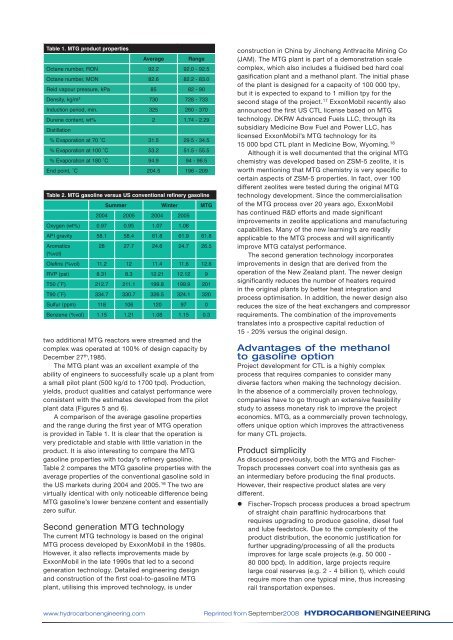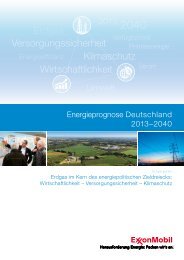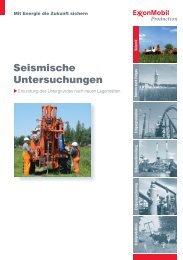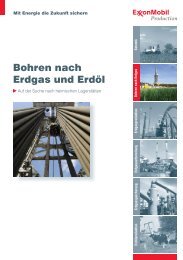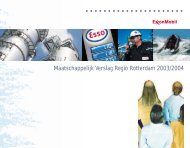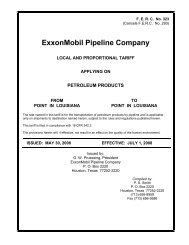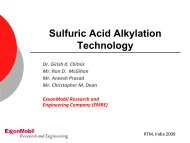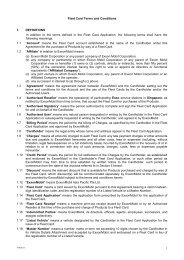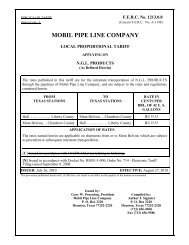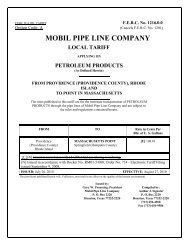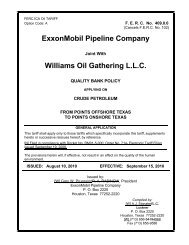Coal to Clean Gasoline - ExxonMobil
Coal to Clean Gasoline - ExxonMobil
Coal to Clean Gasoline - ExxonMobil
You also want an ePaper? Increase the reach of your titles
YUMPU automatically turns print PDFs into web optimized ePapers that Google loves.
Table 1. MTG product properties<br />
Average Range<br />
Octane number, RON 92.2 92.0 - 92.5<br />
Octane number, MON 82.6 82.2 - 83.0<br />
Reid vapour pressure, kPa 85 82 - 90<br />
Density, kg/m 3 730 728 - 733<br />
Induction period, min. 325 260 - 370<br />
Durene content, wt% 2 1.74 - 2.29<br />
Distillation<br />
% Evaporation at 70 ˚C 31.5 29.5 - 34.5<br />
% Evaporation at 100 ˚C 53.2 51.5 - 55.5<br />
% Evaporation at 180 ˚C 94.9 94 - 96.5<br />
End point, ˚C 204.5 196 - 209<br />
Table 2. MTG gasoline versus US conventional refinery gasoline<br />
Summer Winter MTG<br />
2004 2005 2004 2005<br />
Oxygen (wt%) 0.97 0.95 1.07 1.08<br />
API gravity 58.1 58.4 61.8 61.9 61.8<br />
Aromatics<br />
(%vol)<br />
28 27.7 24.6 24.7 26.5<br />
Olefins (%vol) 11.2 12 11.4 11.6 12.6<br />
RVP (psi) 8.31 8.3 12.21 12.12 9<br />
T50 (˚F) 212.7 211.1 199.8 199.9 201<br />
T90 (˚F) 334.7 330.7 326.5 324.1 320<br />
Sulfur (ppm) 118 106 120 97 0<br />
Benzene (%vol) 1.15 1.21 1.08 1.15 0.3<br />
two additional MTG reac<strong>to</strong>rs were streamed and the<br />
complex was operated at 100% of design capacity by<br />
December 27 th ,1985.<br />
The MTG plant was an excellent example of the<br />
ability of engineers <strong>to</strong> successfully scale up a plant from<br />
a small pilot plant (500 kg/d <strong>to</strong> 1700 tpd). Production,<br />
yields, product qualities and catalyst performance were<br />
consistent with the estimates developed from the pilot<br />
plant data (Figures 5 and 6).<br />
A comparison of the average gasoline properties<br />
and the range during the first year of MTG operation<br />
is provided in Table 1. It is clear that the operation is<br />
very predictable and stable with little variation in the<br />
product. It is also interesting <strong>to</strong> compare the MTG<br />
gasoline properties with <strong>to</strong>day’s refinery gasoline.<br />
Table 2 compares the MTG gasoline properties with the<br />
average properties of the conventional gasoline sold in<br />
the US markets during 2004 and 2005. 16 The two are<br />
virtually identical with only noticeable difference being<br />
MTG gasoline’s lower benzene content and essentially<br />
zero sulfur.<br />
Second generation MTG technology<br />
The current MTG technology is based on the original<br />
MTG process developed by <strong>ExxonMobil</strong> in the 1980s.<br />
However, it also reflects improvements made by<br />
<strong>ExxonMobil</strong> in the late 1990s that led <strong>to</strong> a second<br />
generation technology. Detailed engineering design<br />
and construction of the first coal-<strong>to</strong>-gasoline MTG<br />
plant, utilising this improved technology, is under<br />
construction in China by Jincheng Anthracite Mining Co<br />
(JAM). The MTG plant is part of a demonstration scale<br />
complex, which also includes a fluidised bed hard coal<br />
gasification plant and a methanol plant. The initial phase<br />
of the plant is designed for a capacity of 100 000 tpy,<br />
but it is expected <strong>to</strong> expand <strong>to</strong> 1 million tpy for the<br />
second stage of the project. 17 <strong>ExxonMobil</strong> recently also<br />
announced the first US CTL license based on MTG<br />
technology. DKRW Advanced Fuels LLC, through its<br />
subsidiary Medicine Bow Fuel and Power LLC, has<br />
licensed <strong>ExxonMobil</strong>’s MTG technology for its<br />
15 000 bpd CTL plant in Medicine Bow, Wyoming. 18<br />
Although it is well documented that the original MTG<br />
chemistry was developed based on ZSM-5 zeolite, it is<br />
worth mentioning that MTG chemistry is very specific <strong>to</strong><br />
certain aspects of ZSM-5 properties. In fact, over 100<br />
different zeolites were tested during the original MTG<br />
technology development. Since the commercialisation<br />
of the MTG process over 20 years ago, <strong>ExxonMobil</strong><br />
has continued R&D efforts and made significant<br />
improvements in zeolite applications and manufacturing<br />
capabilities. Many of the new learning’s are readily<br />
applicable <strong>to</strong> the MTG process and will significantly<br />
improve MTG catalyst performance.<br />
The second generation technology incorporates<br />
improvements in design that are derived from the<br />
operation of the New Zealand plant. The newer design<br />
significantly reduces the number of heaters required<br />
in the original plants by better heat integration and<br />
process optimisation. In addition, the newer design also<br />
reduces the size of the heat exchangers and compressor<br />
requirements. The combination of the improvements<br />
translates in<strong>to</strong> a prospective capital reduction of<br />
15 - 20% versus the original design.<br />
Advantages of the methanol<br />
<strong>to</strong> gasoline option<br />
Project development for CTL is a highly complex<br />
process that requires companies <strong>to</strong> consider many<br />
diverse fac<strong>to</strong>rs when making the technology decision.<br />
In the absence of a commercially proven technology,<br />
companies have <strong>to</strong> go through an extensive feasibility<br />
study <strong>to</strong> assess monetary risk <strong>to</strong> improve the project<br />
economics. MTG, as a commercially proven technology,<br />
offers unique option which improves the attractiveness<br />
for many CTL projects.<br />
Product simplicity<br />
As discussed previously, both the MTG and Fischer-<br />
Tropsch processes convert coal in<strong>to</strong> synthesis gas as<br />
an intermediary before producing the final products.<br />
However, their respective product slates are very<br />
different.<br />
Fischer-Tropsch process produces a broad spectrum<br />
of straight chain paraffinic hydrocarbons that<br />
requires upgrading <strong>to</strong> produce gasoline, diesel fuel<br />
and lube feeds<strong>to</strong>ck. Due <strong>to</strong> the complexity of the<br />
product distribution, the economic justification for<br />
further upgrading/processing of all the products<br />
improves for large scale projects (e.g. 50 000 -<br />
80 000 bpd). In addition, large projects require<br />
large coal reserves (e.g. 2 - 4 billion t), which could<br />
require more than one typical mine, thus increasing<br />
rail transportation expenses.<br />
www.hydrocarbonengineering.com Reprinted from September2008 HydrocarbonEnginEEring<br />
l


